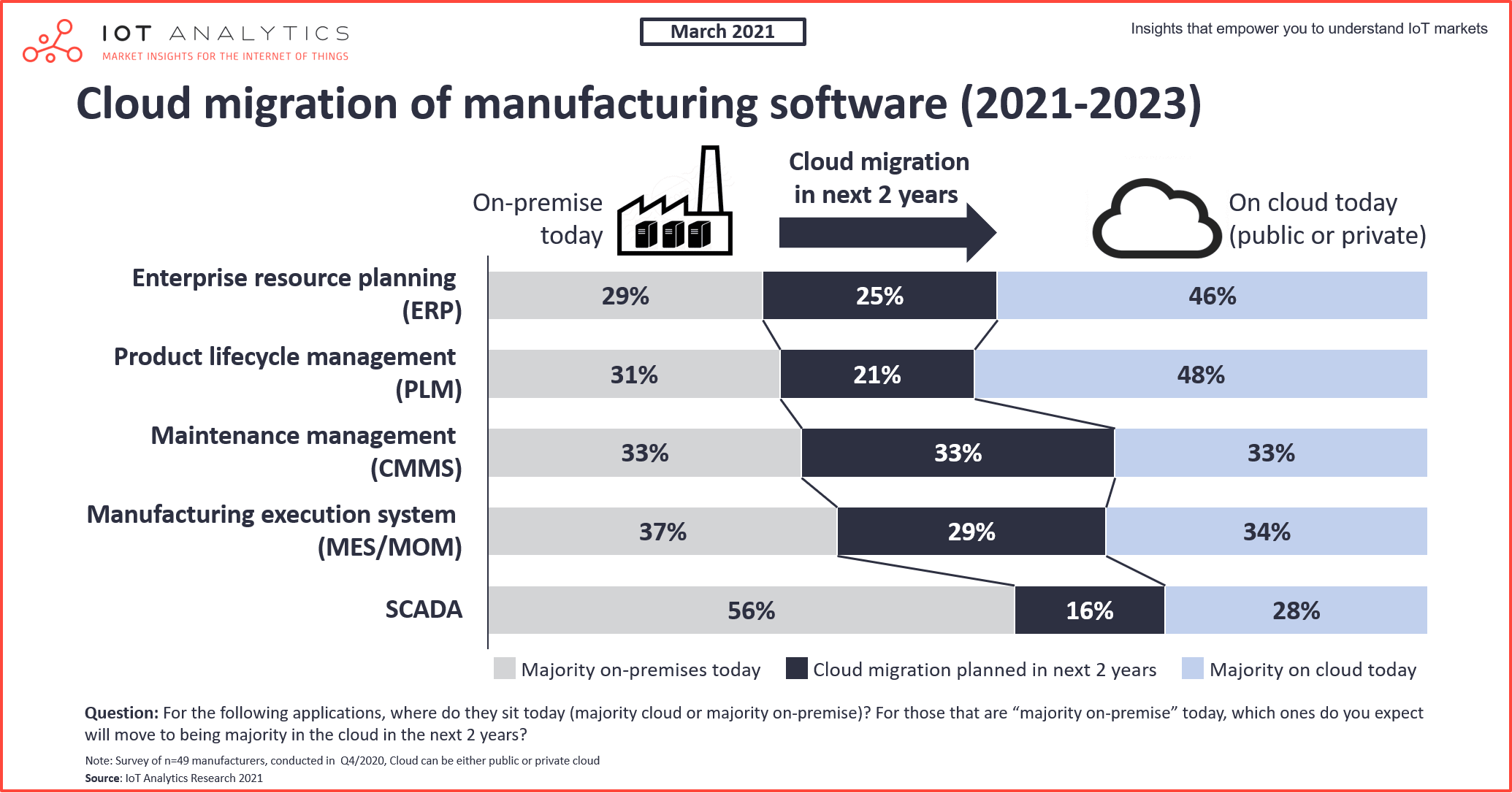
In short
- Enterprise software, such as ERP, is increasingly moving to the cloud; Cloud adoption for manufacturing software, such as MES/MOM, is much lower but accelerating.
- 29% of manufacturers in a recent survey indicated a move of MES software to the cloud in the next 2 years.
- The Cloud MES market is estimated to reach $2.34 billion by 2026.
Why it matters?
- Offering cloud-based MES solutions will provide new business and growth opportunities for manufacturing software vendors.
- Widespread adoption of cloud MES will help manufacturers scale operations globally with complete operational visibility and control.
Introduction
According to the World Economic Forum, it is estimated that by 2025, 463 exabytes (1 exabyte = 1,000,000 TB) of consumer data will be generated every day globally. Factories are expected to add 22 zettabytes (1 zettabyte = 1000 exabyte) of data on top of this.
The challenge is to make use of the data in a meaningful way and use it to create value. However, today, a significant portion (~55%, according to Splunk) of this data is “dark” (i.e., it is not used for any analysis). A major reason why data remains “dark” is because existing tools are not designed to handle the volume and variety of data generated.
In the last few years, companies seeking to “light up” this dark data have increasingly been adopting a technology that allows data to be captured and analyzed in a significantly more powerful way: The cloud.
Migration to the cloud
When compared to existing technologies, the cloud is proving to be more efficient and superior by providing a scalable infrastructure where data can be securely collected and accessed from anywhere and on any device. Migration to the cloud has already proven to be a gamechanger in day-to-day usage for several enterprise software categories. Microsoft 365 has become the de-facto cloud-based standard for enterprise productivity software. The 2020 success story of the Zoom video conferencing tool can be largely attributed to its cloud-native framework that allowed the company to quickly scale and manage new customers during the pandemic.
Our data shows that manufacturing software is following suit. Benefits such as easy scalability, smaller upfront investments and operational costs, fast deployment, and remote accessibility also make the cloud advantageous for factories’ manufacturing software.

A Q4/2020 survey of 49 manufacturers conducted by IoT Analytics showed that the move of manufacturing software to the cloud is broadening and accelerating. While nearly 50% of today’s PLM and ERP systems and roughly one third of MES/MOM and CMMS solutions are already partially deployed in either a private or public cloud environment, many companies are planning to move more such workloads to the cloud in the next 2 years. 29% of respondents, for example, plan to move their manufacturing execution system (or a large part thereof) to the cloud in the next two years.
As can be seen by this data set, migration to the cloud in the manufacturing industry is following a top-down approach along the ISA 95 automation pyramid. ERP and PLM systems were the first software to migrate to the cloud (e.g., Oracle’s Netsuite ERP and Cloud PLM), and now MES/MOM systems and CMMS are increasingly moving to the cloud as well (e.g., Plex Systems, Fiix)
Our research shows there are two very different ways in which these software suites are migrating to the cloud:
- Lift & Shift: The existing software is “lifted” from on-premises and hosted on a private or public cloud infrastructure located off-premises.
- SaaS: The software is “cloud-native”, meaning it is multi-tenant and built on the cloud managed by the software vendor.
The cloud-based MES market
As can be seen in the data set above, there is a clear trend towards cloud MES.
IoT Analytics’ latest report on the topic estimates the cloud penetration of Manufacturing Execution Systems to increase, with cloud MES forecasted to become a $2.34 billion market in 2026.
End users are increasingly adopting cloud MES as it allows them to take advantage of the latest IoT technologies and offers better scalability than on-premise MES systems. Additionally, increased focus and investment on digitization efforts accelerated by the COVID-19 pandemic in developed economies will increase MES migration to the cloud.
The preferred method of migrating MES to the cloud depends on multiple factors such as capital investment, operational expenses, scalability, and data ownership.
Software-as-a-Service architectures are expected to grow considerably faster than Lift and Shift architectures due to the easy initial setup and integration with existing cloud-based software infrastructure. SaaS deployments are often preferred by small and medium corporations looking to digitize their operations with limited upfront investment since SaaS solutions require little to no existing IT infrastructure.
“Lift and shift” architectures simply move the existing on-premise MES software to an off-premises cloud infrastructure. Large corporations with global operational footprints usually prefer this method for upgrading existing MES systems to the cloud. Private cloud-based lift and shift migration is expected to be the dominant cloud type for deploying MES since it provides complete control and ownership of infrastructure, data, and operations to the end-user; however, it is often initially more expensive than using a public cloud-based lift and shift migration.
Key Manufacturing Software Trends in the Cloud
Cloud adoption is also accelerating key trends which will affect the operation of future factories. 3 key trends identified in our analysis include:
1. The convergence of software tools
The capabilities of key manufacturing software tools are overlapping more and more. This is particularly apparent for the interfaces of ERP systems and MES systems as well as IoT Platforms and MES systems, especially when hosted in the cloud. While IoT platforms, for example, were initially optimized for handling a wide range of IoT data generated by connected factories, legacy tools (particularly MES; ERP to a lesser extent) have recently also developed new functionality to handle similar data streams. The ability to handle IoT data is just one of many ways in which MES platform functionalities and IoT platform functionalities are converging in the manufacturing context. As these software tools continue to overlap more, end-users now have multiple options for performing manufacturing software tasks.
2. Increasing integration of AI tools
As the cloud allows powerful computation, manufacturing software increasingly integrate machine learning and AI-based tools that go beyond simple OEE and SPC calculations. Both established MES players and new startups are creating AI-based manufacturing software modules to differentiate themselves. MPDV’s HYDRA MES for example now includes a predictive quality solution. US-based startup Falkonry is basing their entire manufacturing software business around AI/ML, offering solutions such as “predictive production operations”.
3. Increasing integration of digital twin capabilities
Using the fast scalability and massive storage of the cloud, manufacturing software tools (particularly MES and IoT platforms) are increasingly integrating model-based digital representations of factories for process optimization, simulation, what-if/scenario analysis, and other use cases. MES vendor Plex, for example, offers a “what-if” analysis that leverages a digital twin of operations to simulate changes to operations such as new shifts, maintenance downtime, or availability. GE’s Predix APM module offers digital twin-based asset performance management.
Future Outlook
“Historically our members have not talked much about the cloud; ‘Ain’t never going to happen’ was the general attitude. Then in ~2017, all of the sudden it was there. Everyone was secretly using the cloud in some capacity. Technically (from both a security and relability perspective) it performs much better than what they had sitting in their office.”
— Former executive at Manufacturing Enterprise Solutions Association (MESA)
Make no mistake, there are many end users in a variety of industries that indicate that they will never move a significant portion of their manufacturing software to the cloud due to security, privacy, reliability and / or latency concerns. But in the coming years, a large potion of manufacturers will move manufacturing software applications to the cloud because the benefits outweight the costs / risks in many settings. Our data shows that business and shopfloor software that are non-critical and non-real-time will lead the migration. Shopfloor-level control logic operations will take longer to move to the cloud due to gaps in realizing ultra-low latency communication with high reliability; however, new developments in 5G and wireless communication will likely address these concerns and open the door to even more manufacturing workloads eventually migrating to the cloud in the coming decade. In combination with relatively new technologies like artificial intelligence and digital twins, the cloud is set to become an indespesible tool for improving manufacturing operations.
More information and further reading
Are you interested in learning more about Cloud MES?
The “Cloud MES Market Report 2021-2026” is a comprehensive 85-page report assessing the cloud MES market. It includes a definition of cloud MES, market projections, adoption drivers, case study analysis, key trends & developments. It is part of IoT Analytics’ ongoing coverage of Industrial IoT and Industry 4.0 topics (Industrial IoT Research Workstream).

This report provides answers to the following questions (among others):
- What are the functionalities of MES software and how has it evolved over the years?
- What is the adoption level of cloud-based MES solutions?
- What are the different cloud-based solutions available for MES?
- What are the technologies that are accelerating the adoption of cloud MES?
- What are the growth drivers and inhibitors of the cloud MES market?
- How big is the cloud MES market? Market segments include:
- Cloud type (private cloud, public cloud)
- Cloud service type (Lift and shift, Software-as-service)
- Region
- End-user industry
- How competitive is the cloud MES vendor landscape?
- How do cloud-based MES compare to IoT platforms and similar software tools?
- What are the key trends and developments associated with the cloud MES market?
- And more…
Sample:
The sample of the report provides a holistic overview of the available analyses (outline, key slides). The sample also provides additional context on the topic and describes the methodology of the research. You can download the sample here:
Are you interested in continued IoT coverage and updates?
Subscribe to our newsletter and follow us on LinkedIn and Twitter to stay up-to-date on the latest trends shaping the IoT markets. For complete enterprise IoT coverage with access to all of IoT Analytics’ paid content & reports including dedicated analyst time check out Enterprise subscription.

